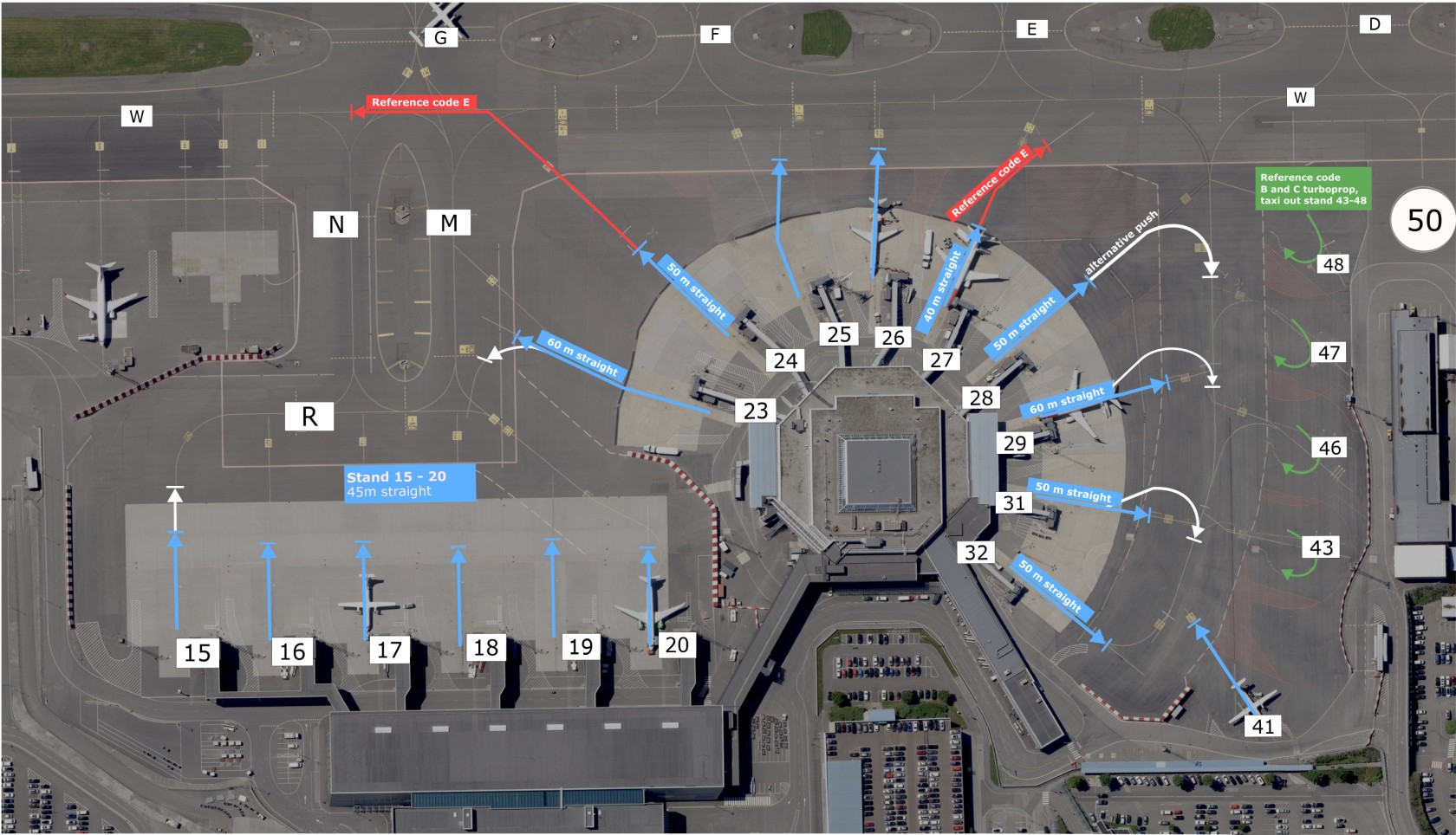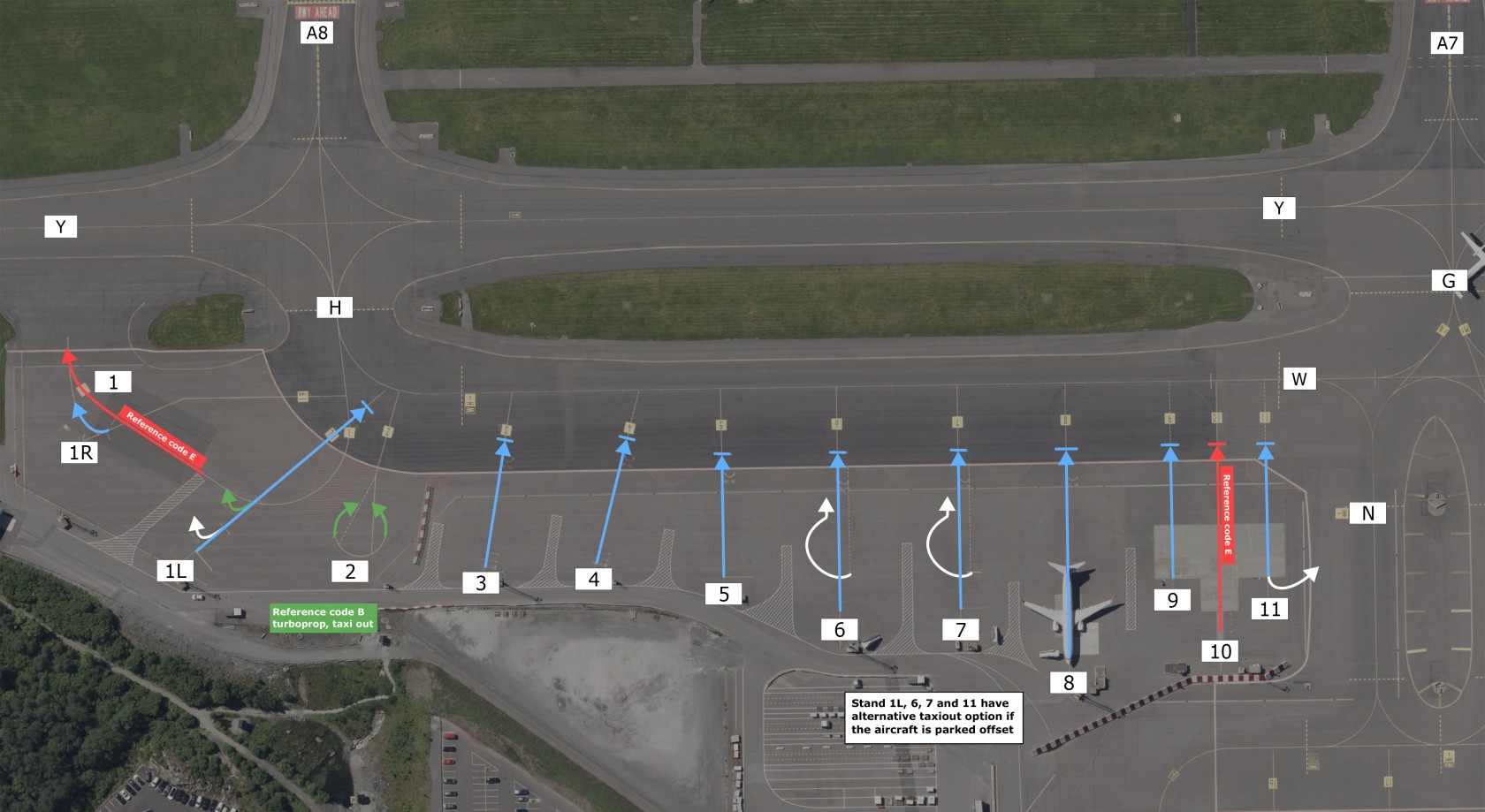ENBR – Bergen Flesland
Overview
Bergen Airport Flesland is the airport of the 2nd biggest city in Norway and covers most of the population in the western side of Norway. The most popular routing is flying over the mountain to Norways main airport at Oslo, but short commuter routes to Stavanger, Bodø, Trondheim, Kristiansand and other cities in Norway are common too. Bergen airport is also serving several European routes to popular vacation routes and important routes to the big hubs in central Europe.
Available stands
Use of stands
Terminal
- Domestic: 15-20, 29-32
- Schengen: 23-32
- Non-Schengen: 23-27
Aprons
- Technical Apron: GA
- North Apron: Ambulance flights, Widerøe
- South Apron: Cargo, Prop, Other
IFR clearance
Initial contact is with Clearance Delivery, reporting callsign, stand number, and latest ATIS identification letter and QNH. If unable to follow SID, please advise on initial contact.
Push-back
Most of the terminal gates require straight-back pushes. However, a few have turn pushes. In the map overview below, you will access all information
Map Overviews
If the stand is not mentioned in the maps, ask the ground controller if you're unsure how to excecute the pushback
Taxi
Taxi instructions include the full taxi route, however the runway intersection is not always included. If for example “holding point runway XX” is stated in your instruction, you may call ATC with “CALLSIGN, ready via ” as you approach this intersection or with the taxi request, and it may be approved if traffic permits. Make sure to double-check if you are able to use the runway length from the intersection before requesting it.
All aircraft are expected to taxi to A1 or A9 (depending of runway in use) GAs is expected to taxi to holding point A4 when runway 17 is in use Helicopters is expected to taxi to holding point A5 (RWY17) and A6 (RWY35)
Runways
There is a single runway available at ENBR, which is runway 17/35.
Helicopters may land on taxiway Y (parallel to the runway) if there are low traffic levels and good visibility conditions.
Please vacate the runway fully. This means the whole aircraft has crossed the stop bar line. If the aircraft is partly over and not fully, the consequences are that we might have to send aircraft around or delay them as the runway is not free.
SIDs
All SIDs are individually numbered for each runway. When receiving your clearance, know that the SID stated is only valid for one runway, in case the controller forgets to state the departure runway. RNAV SIDs at Bergen have an initial climb altitude of 6000ft. If you are unable to follow the published SIDs (old AIRAC, default or non-database freeware aircraft, etc.), request an Omni-directional departure. Omni-directional departures have their own designated SIDs as OMNI3D and OMNI3C. Although it sounds like a normal SID, it's a omni-directional departure. You will find the omni-departure procedures on the chart databases. It is important that you NEVER climb above the initial climb without ATC clearance, as STARs and SIDs cross each other at different altitudes.
Arrival and STARs
Before or at the initial phase of your descent, you will recessive your clearance for STAR and arrival. The arrivals contain many waypoints and restrictions. We recommend preloading the expected STAR and crosschecking so the correct fixes and restrictions have been loaded before descending. This helps you and the aircraft to plan the optimum descend profile and the start of the desende. Although remember to not start on the STAR unless you have been cleared by the controller.
Flesland is using a “Point Merge System”, or PMS. This means that all STARs end up in a “fan” made out of waypoints (RIVIP, GODID, GILVA, GILGU), in which pilots should always be prepared for a direct routing towards the merge waypoint, 4 in total, in order to ease the workload of approach ATC.
Approach
All aircraft can expect ILS W approach, unless it has been instructed to expect another type of approach. If unable to perform the ILS approach, advise the approach controller on initial contact.
The last fix of the STAR (or Merge Point) is followed by a transition to the ILS approach for each runway. ATC often replaces these with vectoring, but always be prepared to fly the transition, and do NOT fly direct from the merge point to the Final Approach Fix. If you have no transitions available, inform ATC and request vectoring.
When you are cleared for the approach via GILVA, GILGU, GODID or RIVIP transition, you are also cleared to continue the descent as long as the restrictions are followed. Usually, the restriction is 4000 feet or above at the transition point, but we recommend as always looking at your chart for the most precise information.
Following approach types is available in ENBR:
| Runway | Approach types |
|---|---|
| 17 | ILS W, LOC W, RNP Z, RNP (AR) E/N/S/W, VOR Helicopter only: ILS Y, LOC Y, RNP 139 |
| 35 | ILS W, LOC W, RNP Z, RNP (AR) E/N/W, VOR Helicopter only: ILS Y, LOC Y, RNP 043 |
1. RNP (AR) approaches are only to be considered to be used at a low-traffic level. RNP Z is available on request.
2. Visual approaches are also available and shall not fly below 2000 feet until established on final. Expect direct to respective points in the visual approach chart when planning for visual approach.
Direct routings
In Norway, direct routings are often used. Both arriving and departing traffic should be prepared to fly direct the end of SIDs, STAR Merge Points, and airspace border fixes. Make sure you have your filed route and waypoint page available to quickly accommodate direct routings.
Communications
You can always check online positions and sectors by visiting vatglasses.uk
ENBR_ATIS – Flesland ATIS – 125.250
ENBR_DEL – Flesland Delivery – 123.400
ENBR_GND – Flesland Ground – 121.900
ENBR_TWR – Flesland Tower – 119.100
ENBR_W_APP – Flesland Approach West – 121.000
ENBR_E_APP – Flesland Approach East – 125.000
ENBR_D_APP – Flesland Director – 118.850
ENSV_CTR – Polaris Control (Stavanger ACC) – 120.650
ENSV_N_CTR – Polaris Control (Stavanger ACC north) – 124.700
ENSV_E_CTR – Polaris Control (Stavanger ACC east) – 134.925
ENOR_CTR - Polaris Control (Bandbox) - 125.500
ENOR_S_CTR - Polaris Control (Bandbox South/Covering southENOS+ENSV of ENVA)AoR) - 121.550
ENRC_S_CTR - Flesland Tower (Bodø Remote Tower Center) - 118.425


